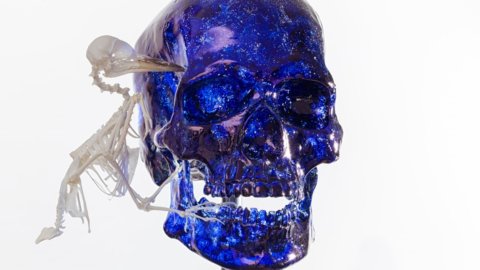Jan Fabre returns to Venice, with an unprecedented project, specially designed for the spaces of the San Gregorio abbey, located between the Accademia bridge and the tip of the Dogana.
Collateral event of the 57th International Art Exhibition – La Biennale di Venezia, from 13 May to 26 November 2017, the Jan Fabre exhibition. Glass and Bone Sculptures 1977-2017, curated by Giacinto Di Pietrantonio, Katerina Koskina and Dimitri Ozerkov, promoted by GAMeC – Galleria d'Arte Moderna e Contemporanea di Bergamo, in collaboration withEMST – National Museum of Contemporary Art of Athens and The State Hermitage Museum of St. Petersburg, presents over 40 sculptures by Jan Fabre (Antwerp, 1958), able to retrace his research from its origins, triggering a philosophical, spiritual and political reflection on life and death through the centrality of metamorphosis.
For the first time, works in glass and bone, created over a period of forty years, between 1977 and 2017, will be brought together.
Fascinated by the alchemy and memory of materials, Jan Fabre was inspired by the pictorial tradition of the Flemish masters who used to mix ground bones with colored pigments and by the craftsmanship of Venetian glassmakers. The artist has deliberately chosen these two hard materials, which are strong despite their delicacy and fragility, to highlight the hardness and fragility of life itself.
“My philosophical and poetic idea – recalls Jan Fabre – which brings together glass with human and animal bones, comes from the memory of my sister who used to play with a small glass object as a child. This got me thinking about the flexibility of human bone compared to that of glass. Some animals and all humans come out of the womb like molten glass out of a cooking kiln. All can be shaped, bent and formed with an astonishing degree of freedom.”
The two materials model parts and sets of human and animal bodies: at times, these maintain their chromatic naturalness; other times, they are painted with the blue color typical of the Bic ballpoint pen that the artist has been using for years to tell the Blue Hour, or that twilight moment in which the transition from night to day or vice versa takes place, which marks the point of border and change of natural time.
“In fact – says Giacinto Di Pietrantonio – we could add Blue Bic Ink to the title Glass and Bone. Matter, in Fabre's work, is not celebrated in a phenomenal sense, but is used as a messenger of arcane symbols connected with its very essence. In searching for him, Fabre does not pursue an art that evaluates history as a product of the present, or rather of sociology, but rather as a struggle that unfolds within a material whose memory has dissolved in the depths of time”
The dialectic between bones and glass, which is the one that is established, for example, between hardness and fragility, between opacity and transparency, between shadow and light, between tangible and intangible, between life and death, is at the center of the poetics of Fabre. The Flemish artist's art revolves around the unstable state of metamorphosis and changes in the flow of existence. Like glass, bones are also not indestructible. Like glass, bones break showing human fragility and precariousness.
“Jan Fabre's glass and bone sculptures – declares Katerina Koskina – are a tacit allusion to the brevity of life on earth and our mortality. Likewise, the connection between bone and glass alludes to the fragility and transience of human existence. Bones and the sheen of glass, symbols of death and opulence respectively, share the precariousness of human life which has only a brief flash of time in which to enjoy beauty before the body turns into a skeleton.
For his part, Dimitri Ozerkov points out that “Fabre crystallizes both the bones and the glass and makes them sacred. And it does the same with human existence in its mystical temporal presence in reality, guided by the imagination. For him, the artistic imagination is the clearest proof of human existence, and he finds it somewhere, between the bones and the glass, between the body and the soul”.
Throughout his career, Fabre has always dealt with these two materials; since 1977, when he created The Pacifier, a pacifier made of bone, but wrapped in glass splinters that can't be used unless you want to hurt yourself. And made of glass was the primitive altar of human bones in The Future Merciful Vagina and Phallus (2011) on top of which were a pelvic bone and a phallus.
In Jan Fabre's research, bones are associated with death. In the Pietas, presented during the 2011 Art Biennale at the Nuova Scuola Grande di Santa Maria della Misericordia in Venice, which reproduced Michelangelo's Pietà on a 1:1 scale, the face of the Madonna had been replaced by a skull, the image of death .
Jan Fabre (Antwerp, 1958). Biographical notes
For over 35 years, Jan Fabre has been one of the most innovative and important figures on the international contemporary art scene. As a visual artist, playwright and author, Fabre reflects on life and death, on physical and social transformations, as well as on the cruel and intelligent representation of animals and human beings. Jan Fabre was the first living artist to hold a major exhibition at the Louvre Museum in Paris (L'ange de la Métamorphose, 2008) and at the States Museum in St. Petersburg (Knight of Despair / Warrior of Beauty, 2016-2017) .
image. Jan Fabre, Skull with Woodpecker (2017) Size: 53,6 cm x 24,9 cm x 22,3 cm Techn: Murano Glass, Skeleton of a Woodpecker, Bic Ink, Stainless Steel Photographer: Pat Verbruggen Copyright: Angelos bvba





